 |
PSYCHOANALYTIC APPROACHES TO COUNSELING:View of Human Nature |
| << THEORY IN THE PRACTICE OF COUNSELING:Timing of Termination |
| CLASSICAL PSYCHOANALYTIC APPROACH:Psychic Determination, Anxiety >> |
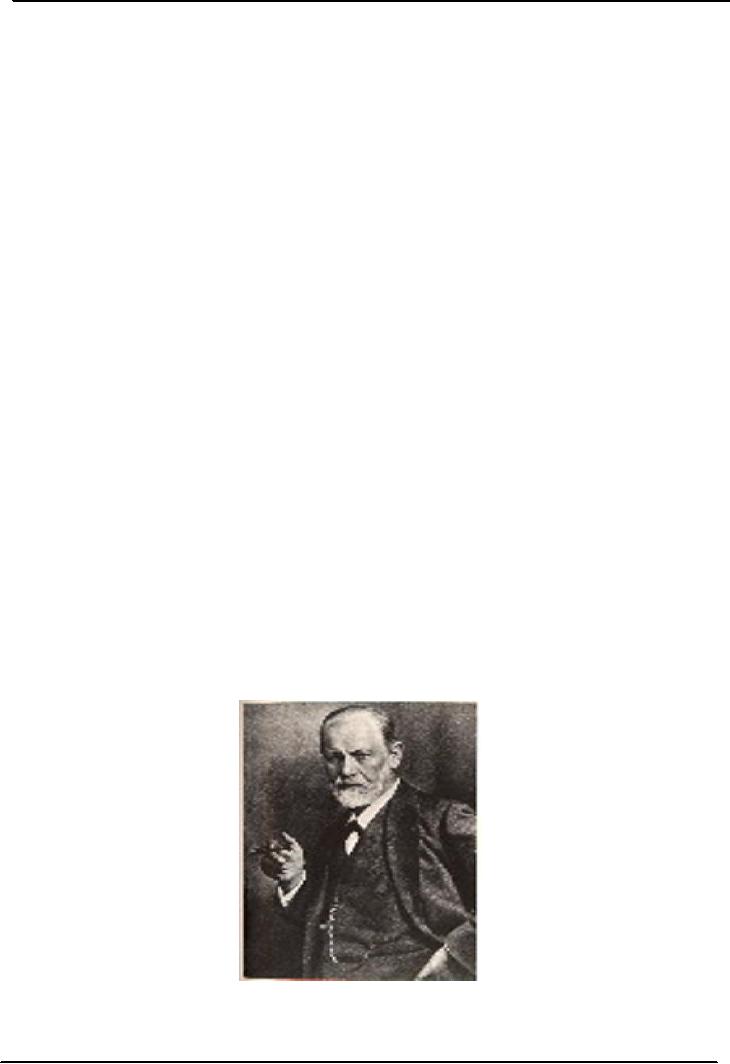
Theory
and Practice of Counseling -
PSY632
VU
Lesson
23
PSYCHOANALYTIC
APPROACHES TO COUNSELING
Counseling
Approaches
Most
counseling approaches, other than
eclecticism fall within four
broad theoretical categories as
mentioned
below:
�
Psychoanalytic
�
Affective
�
Cognitive
�
Behavioral
We
will examine the following
aspects of each theory to facilitate
comparisons:
o
View
of human nature
o
Role
of the counselor
o
Goals
o
Techniques
o
Evaluation
of uniqueness and limitations
o
Case
approach
The
impact of psychoanalysis on the field of
counseling is profound, and
its theories have provided
an
insight
into human behavior more
than any other approach.
Other approaches are divided
according to
their
emphasis on feelings and
behavior. Each approach
recognizes both aspects, feeling
and thinking, but
places
a primary emphasis on one of the
two.
Classical
Psychoanalytic Approach
Many
prominent theories if counseling
(for example, Alfred Adler,
Albert Ellis, Rollo May,
and Fritz Perls)
were
directly influenced by Freud's concepts,
either through association with Freud
himself or because they
were
taught his ideas. Some
theorists (including Carl
Rogers, B.F. Skinner, Alfred
Adler, Perls) developed
theories
in direct opposition to Freud's principles.
Still others (such as Carl
Jung, Anna Freud, Erik
Erikson,
Harry
Stack Sullivan, Karen Horney,
and Heinz Kohut) modified
Freudian concepts in developing
their
own
ideas and concepts.
Sigmund
Freud
Freud
was born at Feiburg, Austria, in 1856
and obtained medical degree in
1881. Without
question,
99
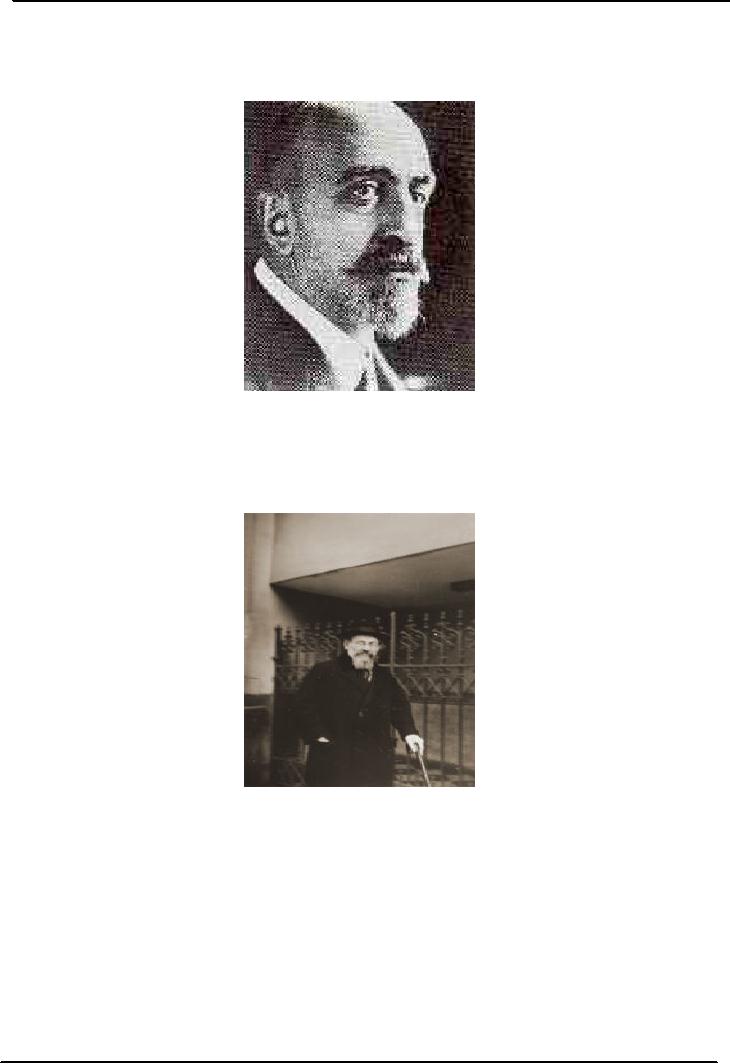
Theory
and Practice of Counseling -
PSY632
VU
psychoanalytic
theory represents one of the
most sweeping contributions to the
field of personality. Almost
every
form of therapy that relies on verbal
transactions between therapist and
patient owes some debt
to
psychoanalysis.
Jean
Charcot
He
mastered in France under the famous
neurologist Jean Charcot. He was
fascinated by Joseph
Breurer's
work.
With a young hysterical patient
called Anna. Breurer used
hypnosis after which her symptoms
were
relieved.
Joseph
Breuer
Freud
was not good hypnotist
himself. However, he soon discovered
that much of his success
depended on
the
relationship he developed during the treatment process
rather than on the hypnosis itself. Freud
added a
new
twist to it by pressing his hand on
patient' foreheads whenever they
began to block out
materials
verbally.
Freud called this method free
association. He used it to explore the
unconscious minds of
his
patients,
and the material uncovered in the
process became the stuff of
interpretation and analysis.
Thus,
psychoanalysis
was born.
Despite
controversial concepts, his ideas
attracted a number of followers. Many of
Freud's colleagues,
and
later
the general public, were
outraged by his emphasis on the
importance of sexually and aggression in
the
etiology
of personality. Nevertheless, his ideas
attracted a number of followers, and in
1902 he formally
organized
in his home what became
known in 1908 as the Viennese
Psychoanalytic Society. This
group
100
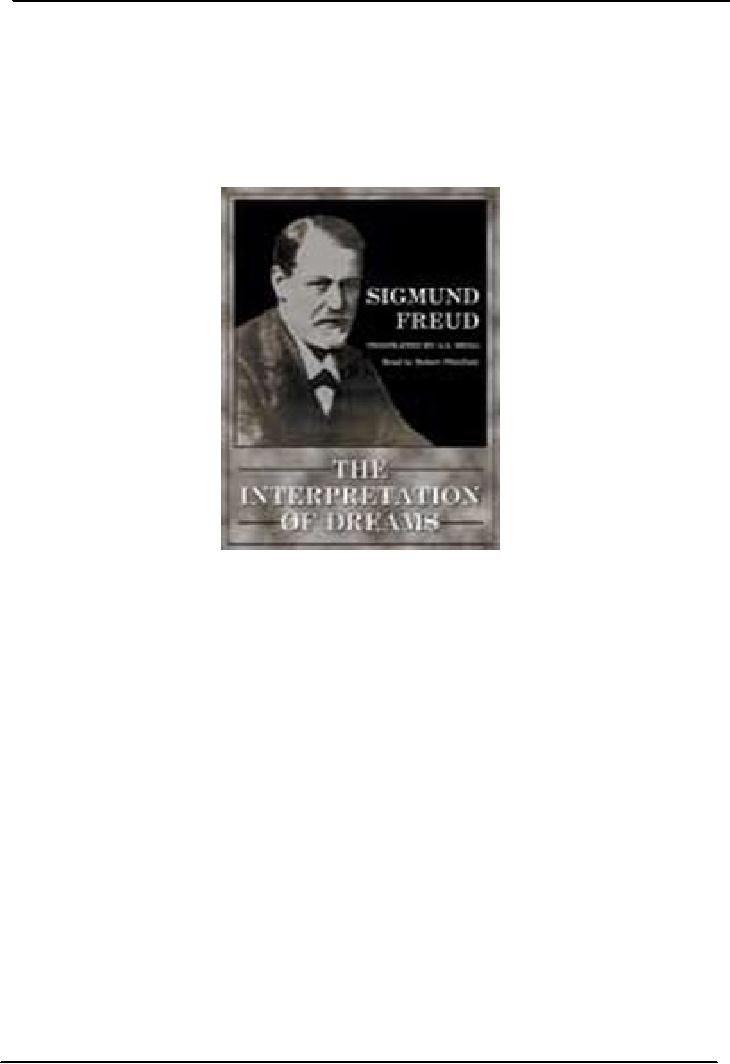
Theory
and Practice of Counseling -
PSY632
VU
acquired
international prominence when Freud was
invited in 1908 to lecture at Clark
University. Freud
died
in London in 1939.
View
of Human Nature
Many
of his main tenets were
set down in his books:
"The
Interpretation of Dreams", "New
introductory Lectures
on
psycho-analysis", and
"The
Ego and the
Id".
The
Interpretation of Dreams
The
Freudian view of human nature is
dynamic as he believed in the transformation
and exchange of
energy
within
the personality. For Freud, human
nature could be explained in terms of a
conscious mind, a
preconscious
mind and an unconscious
mind:
�
Conscious--In
Freudian terms, thoughts or motives that
a person is currently aware of or
is
remembering
�
Preconscious--Freud's
term for thoughts or motives that
one can become aware of
easily
�
Unconscious--Freud's
term for thoughts or motives that lie
beyond a person's normal awareness
but
that can be made available
through psychoanalysis.
He
uses the metaphor of an iceberg as an
analogy to unconscious. According to
him, the 10% of an iceberg
are
visible (conscious), 90% are beneath the
water (preconscious and
unconscious), whereas
the
unconscious
is allotted overwhelming 75-80%.
101
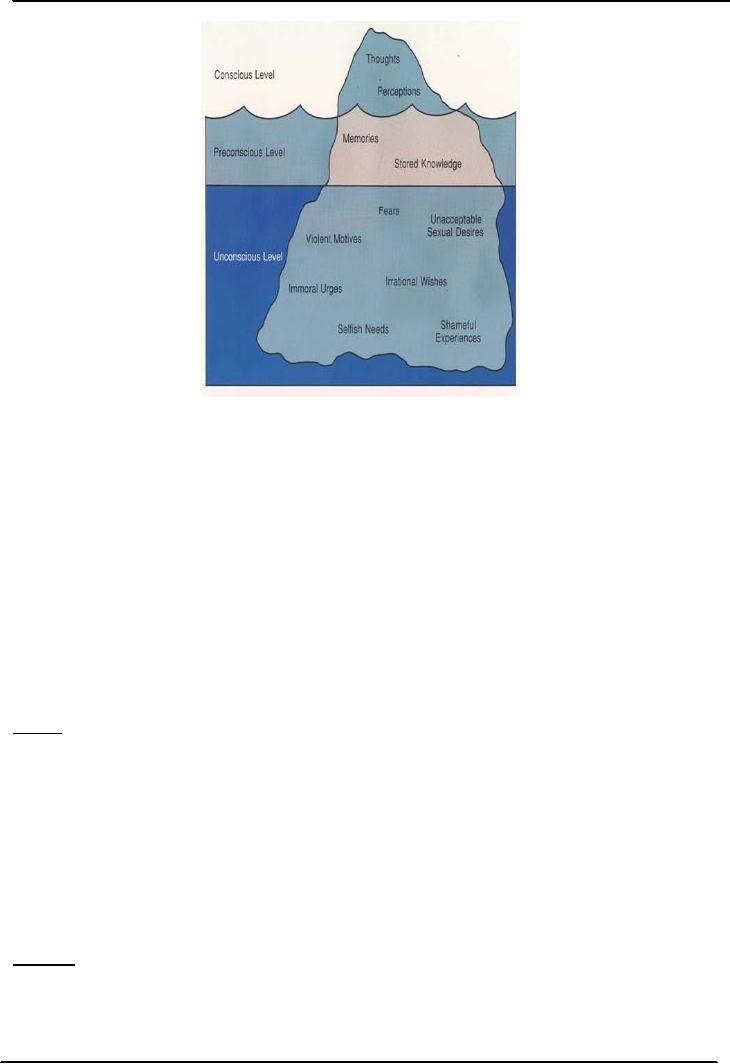
Theory
and Practice of Counseling -
PSY632
VU
Evidence
for the Unconscious
�
Dreams:
symbolic of needs, wishes,
anxieties, conflicts.
�
Slips
of the tongue: Freudian slips, what you
really wanted to say are
shown in slips of tongue.
Posthypnotic
suggestions: After hypnosis people
obey the commands given by the hypnotist
during
the
hypnosis. It shows that
posthypnotic suggestions stay
somewhere, i.e.,
unconscious
Material
from free association: Why
would I think of what is revealed
during free
association?
Material
from projective tests: Things
revealed through projective
tests come from
unconscious.
The
Structure of Personality
According
to Freud, the personality consists of three
parts:
Id
Ego
Superego
The
Id
The
id and the superego are
confined to the unconscious; the ego
operates primarily in the conscious,
but
also
in the preconscious and unconscious. Id
is the demanding child which
never matures and remains
the
spoiled
brat. It does not think only
wishes or acts. It is illogical, amoral,
and driven to satisfy
instinctual
drives.
The id operates through
drivers, instincts, and
images (such as dreaming, hallucinating,
and
fantasizing)
a thought process known as
primary
process. If
empowered and left on its
own, the id would
probably
destroy a person or cause
trouble by acting on the primitive,
aggressive, and sexual
drives it
harbors.
The id contains basic life
energy, collectively known as eros
and basic death instints,
known as
thanatos.
At first Freud associated eros
with sexuality, but later he modified
this idea, describing all
life-
preserving
instincts as eros and the
psychic energy that
accompanies them as libido. Any
acts of aggression,
as
well as foolishly dangerous
behaviors such as taking
unnecessary risks, were
displays of thanatos.
The
Ego
The
Ego is the traffic cop or
executive of the personality. It has
contact with external world of
reality. The
executive
who controls and regulates the
personality:
o
Mediates
between instincts and the environment
102

Theory
and Practice of Counseling -
PSY632
VU
o
Controls
consciousness and exercises censorship
o
Ruled
by the reality principle
The
Superego
The
superego is the judge of human
personality.
o
Ruled
by moral principle
o
Judicial
branch of personality
The
main concern of superego is whether
something is bad or good, right or wrong.
It represents the ideal.
It
functions to inhibit the Id and to
persuade the ego and strive
for perfectionism. It acts as a parent
and
society
in relation to rewards and
punishments:
o
Rewards
create feelings of
pride/self-love.
o
Punishments
create feelings of
guilt/inferiority.
Psychosexual
Stages of Development
Freud
describes five developmental periods
during which particular kinds of
pleasures must be gratified
if
personality
development is to proceed normally. Each
is marked by the involvement of a
particular
erogenous
zone of the body.
Oral
stage:
�
0-18
months--infant receives satisfaction
through sucking, eating,
biting, etc. Erogenous zone
is
the
mouth.
�
Overindulgent--gullible,
dependent, and
passive
�
Underindulgent--aggressive,
sadistic person
�
Oral
fixated adults orient their
life around their mouth by overeating,
alcoholism, smoking,
talking
too
much
Anal
stage:
�
18 months-3
years--the child receives
satisfaction by having and retaining
bowel movements.
Erogenous
zone is the anus.
�
Fixation
results in retentive or explosive personality
�
Anal-retentive--highly
controlled, compulsively neat
�
Anal-explosive--messy,
disorderly, rebellious, and
destructive
Phallic
Stage:
�
3-6
years--center of pleasure is the genitals,
typically a time of exploration of
pleasure through
masturbation
and "playing doctor"
�
Child
resolves the Oedipus Complex--(the
period of conflict during the
phallic stage when
children
are sexually attracted to the
opposite-sex parent and hostile toward
the same-sex parent
�
Castration
anxiety in males and penis envy in
girls
Latency
period:
After
the phallic stage, between
ages 6 and 12, is a quit
period known as latency. At this time
there is little
manifest
interest in sexually. Instead, energy is
focused on peer activities and
personal mastery of
cognitive
learning
and physical skills.
103
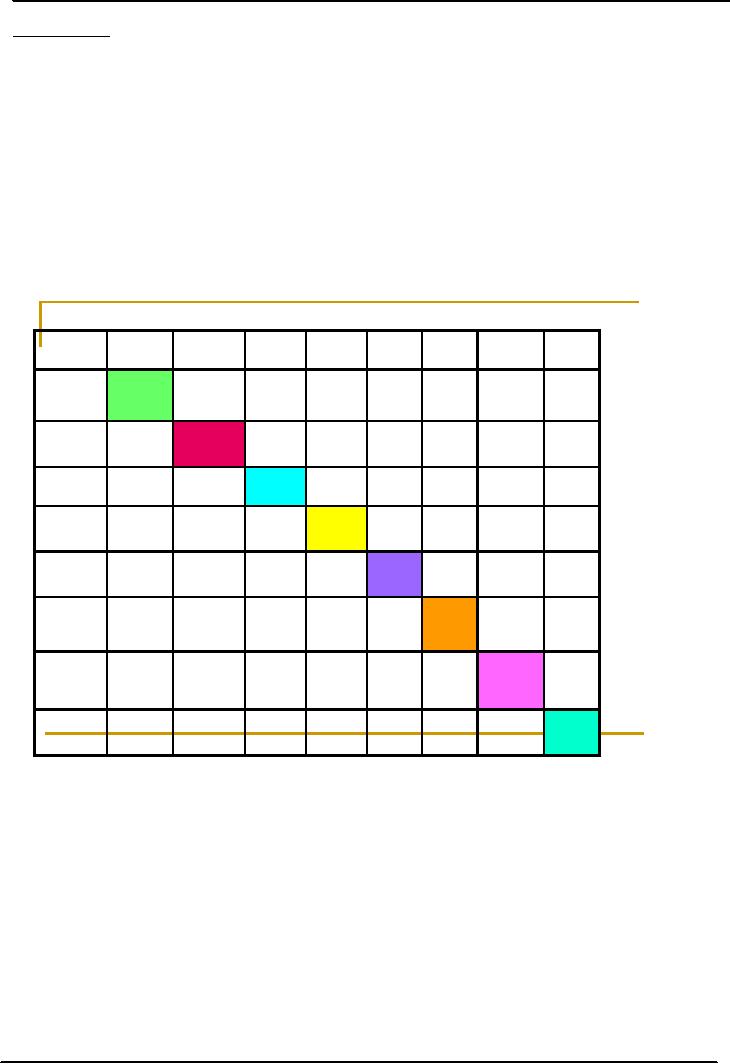
Theory
and Practice of Counseling -
PSY632
VU
Genital
stage:
Around
puberty, the last of the psychosexual
phases occurs, the genital stage. If
all has gone well
previously,
each
gender takes more interest
in the other and normal
heterosexual patterns of interaction
appear.
Frustration
or overindulgence:
Freud
believed that two difficulties could
arise in the pregenital stages; excessive
frustration or
overindulgence.
In such cases, the person
become fixated (or arrested)
at the level of development and
overly
dependent on the use of defense
mechanisms.
Erik
Erikson's (1963,1982) psychosocial theory
extends Freuds developmental emphasis
over the life span,
focusing
on the achievement on specific life-enhancing
tasks. The stages of development
and their
accompanying
ages are presented in the
following table.
Freud
(Psychosexual) vs. Erikson (Psychosocial
stages of developm ent
Stage
1
2
3
4
5
6
7
8
Stage
Basic
T rust
Oral
Vs.Mistrust
Infancy
Anal
Autonomy
Vs.Shame,D
Early
oubt
Childhood
Phallic
Initiative
Vs.Guilt
Pre-School
Latency
Industry
Age
Vs.Inferior
ity
Genital
Identity
School
Age
Vs.Confu
sion
Adolescence
Adulthood
Intimacy
Vs.Isolati
on
Young
Adulthood
Generati
vit
y
Vs.Stagnati
Middle
Age
on
Integrity
Vs.Desp
Later
Life
air
104
Table of Contents:
- INTRODUCTION:Counseling Journals, Definitions of Counseling
- HISTORICAL BACKGROUND COUNSELING & PSYCHOTHERAPY
- HISTORICAL BACKGROUND 1900-1909:Frank Parson, Psychopathic Hospitals
- HISTORICAL BACKGROUND:Recent Trends in Counseling
- GOALS & ACTIVITIES GOALS OF COUNSELING:Facilitating Behavior Change
- ETHICAL & LEGAL ISSUES IN COUNSELING:Development of Codes
- ETHICAL & LEGAL ISSUES IN COUNSELING:Keeping Relationships Professional
- EFFECTIVE COUNSELOR:Personal Characteristics Model
- EFFECTIVE COUNSELOR:Humanism, People Orientation, Intellectual Curiosity
- EFFECTIVE COUNSELOR:Cultural Bias in Theory and Practice, Stress and Burnout
- COUNSELING SKILLS:Microskills, Body Language & Movement, Paralinguistics
- COUNSELING SKILLS COUNSELOR’S NONVERBAL COMMUNICATION:Use of Space
- COUNSELING SKILLS HINTS TO MAINTAIN CONGRUENCE:
- LISTENING & UNDERSTANDING SKILLS:Barriers to an Accepting Attitude
- LISTENING & UNDERSTANDING SKILLS:Suggestive Questions,
- LISTENING & UNDERSTANDING SKILLS:Tips for Paraphrasing, Summarizing Skills
- INFLUENCING SKILLS:Basic Listening Sequence (BLS), Interpretation/ Reframing
- FOCUSING & CHALLENGING SKILLS:Focused and Selective Attention, Family focus
- COUNSELING PROCESS:Link to the Previous Lecture
- COUNSELING PROCESS:The Initial Session, Counselor-initiated, Advice Giving
- COUNSELING PROCESS:Transference & Counter-transference
- THEORY IN THE PRACTICE OF COUNSELING:Timing of Termination
- PSYCHOANALYTIC APPROACHES TO COUNSELING:View of Human Nature
- CLASSICAL PSYCHOANALYTIC APPROACH:Psychic Determination, Anxiety
- NEO-FREUDIANS:Strengths, Weaknesses, NEO-FREUDIANS, Family Constellation
- NEO-FREUDIANS:Task setting, Composition of Personality, The Shadow
- NEO-FREUDIANS:Ten Neurotic Needs, Modes of Experiencing
- CLIENT-CENTERED APPROACH:Background of his approach, Techniques
- GESTALT THERAPY:Fritz Perls, Causes of Human Difficulties
- GESTALT THERAPY:Role of the Counselor, Assessment
- EXISTENTIAL THERAPY:Rollo May, Role of Counselor, Logotherapy
- COGNITIVE APPROACHES TO COUNSELING:Stress-Inoculation Therapy
- COGNITIVE APPROACHES TO COUNSELING:Role of the Counselor
- TRANSACTIONAL ANALYSIS:Eric Berne, The child ego state, Transactional Analysis
- BEHAVIORAL APPROACHES:Respondent Learning, Social Learning Theory
- BEHAVIORAL APPROACHES:Use of reinforcers, Maintenance, Extinction
- REALITY THERAPY:Role of the Counselor, Strengths, Limitations
- GROUPS IN COUNSELING:Major benefits, Traditional & Historical Groups
- GROUPS IN COUNSELING:Humanistic Groups, Gestalt Groups
- MARRIAGE & FAMILY COUNSELING:Systems Theory, Postwar changes
- MARRIAGE & FAMILY COUNSELING:Concepts Related to Circular Causality
- CAREER COUNSELING:Situational Approaches, Decision Theory
- COMMUNITY COUNSELING & CONSULTING:Community Counseling
- DIAGNOSIS & ASSESSMENT:Assessment Techniques, Observation
- FINAL OVERVIEW:Ethical issues, Influencing skills, Counseling Approaches